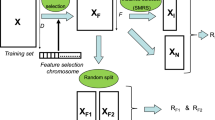Abstract
Image annotation technique can be formulated as a multi-class classification problem, which can be solved by the ensemble of multiple class-pair classifiers. Support vector machine (SVM) classifiers based on optimal class-pair feature subsets from the multimedia content description interface (MPEG-7) standard are used as the class-pair classifiers. We use a binary-coded chromosome genetic algorithm (GA) to select optimal class-pair feature subsets, and a bi-coded chromosome GA to simultaneously select optimal class-pair feature subsets and corresponding optimal weight subsets, i.e. optimal class-pair weighted feature subsets. We consider two kinds of methods for class-pair feature selection: a common optimal (or weighted) feature subset is selected for all the class-pairs, and an individual optimal (or weighted) feature subset is selected for each class-pair respectively. Majority voting scheme is used to combine the class-pair SVM classifiers. The experiments are performed on two different image sets to validate the performance of our image annotation techniques.
Similar content being viewed by others
References
Anagnostopoulos A, Broder A, Punera K (2008) Effective and efficient classification on a search-engine model. Knowl Inform Syst 16(2): 129–154
Bober M (2001) MPEG-7 visual shape descriptor. IEEE Trans Circuits Syst Video Technol 11(6): 716–719
Carneiro G, Chan AB, Moreno PJ, Vasconcelos N (2007) Supervised learning of semantic classes for image annotation and retrieval. IEEE Trans Pattern Anal Mach Intell 29(3): 394–410
Chang E, Goh KS, Sychay G, Wu G (2003) CBSA: content-based soft annotation for multimodal image retrieval using Bayes point machines. IEEE Trans Circuits Syst Video Technol 13(1): 26–38
Chang SF, Chen W, Sundaram H (1998) Semantic visual templates: linking visual features to semantics. In: Proceedings of the IEEE international conference of image processing, pp 531–535
Chi MM, Bruzzone L (2006) An ensemble-driven k-NN approach to ill-posed classification problems. Pattern Recognit Lett 27(4): 301–307
Chiang TW, Tsai T (2008) Query color images using user specified wavelet features. Knowl Inform Syst 15(1): 109–129
Datta R, Joshi D, Wang J (2008) Image retrieval: ideas, influences, and trends of the new age. ACM Comput Surv 40(2): 1–60
Djordjevic D, Izquierdo E (2007) An object-and user-driven system for semantic-based image annotation and retrieval. IEEE Trans Circuits Syst Video Technol 17(3): 313–323
Duygulu P, Banard K, de Freitas JFG, Forsyth DA (2002) Object recognition as machine translation: learning a lexicon for a fixed image vocabulary. In: Proceedings of the 7th European conference on computer vision, pp 97–112
Freund Y, Schapire RE (1997) A decision-theoretic generalization of on-line learning and an application to boosting. J Comput Syst Sci 55(1): 119–139
Gao YL, Fan JP, Luo HZ, Xue XY, Jain R (2006) Automatic image annotation by incorporating feature hierarchy and boosting to scale up SVM classifiers. In: Proceedings of the 14th international conference of multimedia, pp 901–910
Garcia-Pedrajas N, Ortiz-Boyer D (2006) Improving multiclass pattern recognition by the combination of two strategies. IEEE Trans Pattern Anal Mach Intell 28(6): 1001–1006
Goh KS, Chang EY, Li B (2005) Using one-class and two-class SVMs for multiclass image annotation. IEEE Trans Knowl Data Eng 17(10): 1333–1346
Hamdani TM, Alimi AM, Karray F (2006) Distributed genetic algorithm with bi-coded chromosomes and a new evaluation function for features selection. In: Proceedings of the IEEE congress on evolutionary computation, pp 581–588
Huang SH, Wu QJ, Lai SH (2006) Improved AdaBoost-based image retrieval with relevance feedback via paired feature learning. Multimedia Syst 12(1): 14–26
Jeon J, Lavrenko V, Manmatha R (2003) Automatic image annotation and retrieval using cross-media relevance models. In: Proceedings of SIGIR conference on research and development in information retrieval, pp 119–126
Katakis I, Tsoumakas G, Vlahavas I (2009) Tracking recurring contexts using ensemble classifiers: an application to email filtering. Knowl Inform Syst (in press)
Li J, Wang JZ (2003) Automatic linguistic indexing of pictures by a statistical modeling approach. IEEE Trans Pattern Anal Mach Intell 25(19): 1075–1088
Li W, Sun MS (2006) Incorporating prior knowledge into multi-label boosting for cross-modal image annotation and retrieval. Lect Notes Comput Sci 4182: 404–415
Liu XZ, Zhang L, Li MJ, Zhang HJ, Wang DX (2005) Boosting image classification with LDA-based feature combination for digital photograph management. Pattern Recognit 38(6): 887–901
Liu Y, Zhang D, Lu GJ, Ma WY (2007) A survey of content-based image retrieval with high-level semantics. Pattern Recognit 40(4): 262–282
Manjunath BS, Ohm JR, Vasudevan VV, Yamada A (2001) Color and texture descriptors. IEEE Trans Circuits Syst Video Technol 11(6): 703–715
Oh IS, Lee JS, Moon BR (2004) Hybrid genetic algorithms for feature selection. IEEE Trans Pattern Anal Mach Intell 26(11): 1424–1437
Ou GB, Murphey YL (2007) Multi-class pattern classification using neural networks. Pattern Recognit 40(1): 4–18
Peng T, Zuo WL, He FL (2008) SVM based adaptive learning method for text classification from positive and unlabeled documents. Knowl Inform Syst 16(3): 281–301
Qi XJ, Han YT (2007) Incorporating multiple SVMs for automatic image annotation. Pattern Recognit 40(4): 728–741
Shi R, Chua TS, Lee CH, Gao S (2006) Bayesian learning of hierarchical multinomial mixture models of concepts for automatic image annotation. Lect Notes Comput Sci 4071: 102–112
Tieu K, Viola P (2000) Boosting image retrieval. In: Proceedings of the IEEE conference on computer vision and pattern recognition, pp 228–235
Wang BX, Japlowicz N (2009) Boosting support vectors for imbalanced data sets. Knowl Inform Syst (in press)
Zhuang Y, Liu X, Pan Y (1999) Apply semantic template to support content-based image retrieval. Lect Notes Comput Sci 3972: 442–449
Author information
Authors and Affiliations
Corresponding author
Rights and permissions
About this article
Cite this article
Lu, J., Li, R., Zhang, Y. et al. Image annotation techniques based on feature selection for class-pairs. Knowl Inf Syst 24, 325–337 (2010). https://doi.org/10.1007/s10115-009-0240-0
Received:
Revised:
Accepted:
Published:
Issue Date:
DOI: https://doi.org/10.1007/s10115-009-0240-0




